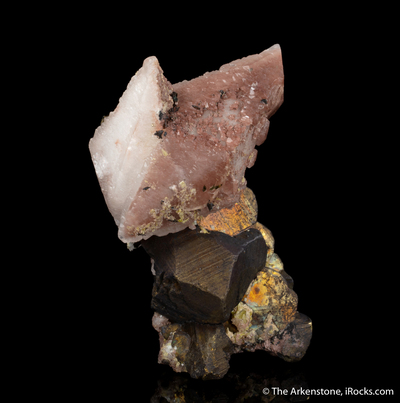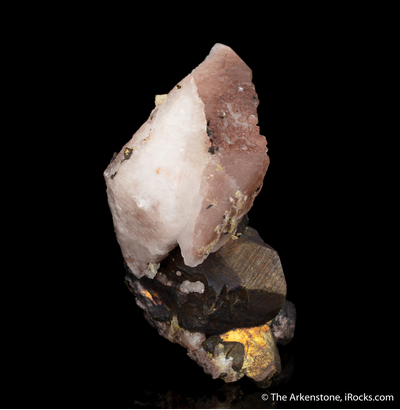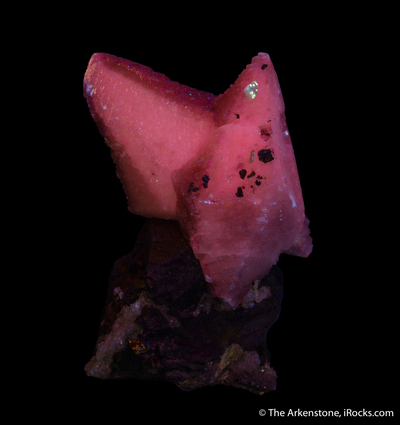7.4cm x 5.6cm x 4.0cm

Photo added to mindat.org
“7.4 x 5.6 x 4.0 cm. Two large lustrous calcite crystals, with a secondary growth of hematite included calcite, sit on top of a spire of chalcopyrites with associated epidote. This specimen was collected by Bill Pyrochodko, a biology professor from Wayne State, in the 1960s and given to his good friend and student, Robert Nowakowski. Later this specimen became a part of the Stoudt Mexican collection. What really makes this specimen special is the story it tells of the paragenesis at Concepcion de Oro deposit. Furthermore; the calcite also tells an interesting story, iron oxides were predominantly preferentially deposited on one side of the initial stage of calcite creating a phantom and subsequent calcite growth was effected on this same side. Making this piece even more interesting, tiny epidote crystals are caught up in the calcite on the side with the phantom; suggesting that this later stage of calcite is associated with the iron and magnesium bearing hydrothermal fluids. On top of that this specimen is violently fluorescent, probably because of temporarily distal remobilization of manganese concurrently with the deposition of the calcite. Essentially, the absolutely intriguing story this specimen tells about the deposit. Ex David and Emily Stoudt Collection.
”
Robert Lavinsky - 26th October 2019

Photo added to mindat.org
“7.4 x 5.6 x 4.0 cm. Two large lustrous calcite crystals, with a secondary growth of hematite included calcite, sit on top of a spire of chalcopyrites with associated epidote. This specimen was collected by Bill Pyrochodko, a biology professor from Wayne State, in the 1960s and given to his good friend and student, Robert Nowakowski. Later this specimen became a part of the Stoudt Mexican collection. What really makes this specimen special is the story it tells of the paragenesis at Concepcion de Oro deposit. Furthermore; the calcite also tells an interesting story, iron oxides were predominantly preferentially deposited on one side of the initial stage of calcite creating a phantom and subsequent calcite growth was effected on this same side. Making this piece even more interesting, tiny epidote crystals are caught up in the calcite on the side with the phantom; suggesting that this later stage of calcite is associated with the iron and magnesium bearing hydrothermal fluids. On top of that this specimen is violently fluorescent, probably because of temporarily distal remobilization of manganese concurrently with the deposition of the calcite. Essentially, the absolutely intriguing story this specimen tells about the deposit. Ex David and Emily Stoudt Collection.
”
Robert Lavinsky - 26th October 2019

Photo added to mindat.org
“7.4 x 5.6 x 4.0 cm. Two large lustrous calcite crystals, with a secondary growth of hematite included calcite, sit on top of a spire of chalcopyrites with associated epidote. This specimen was collected by Bill Pyrochodko, a biology professor from Wayne State, in the 1960s and given to his good friend and student, Robert Nowakowski. Later this specimen became a part of the Stoudt Mexican collection. What really makes this specimen special is the story it tells of the paragenesis at Concepcion de Oro deposit. Furthermore; the calcite also tells an interesting story, iron oxides were predominantly preferentially deposited on one side of the initial stage of calcite creating a phantom and subsequent calcite growth was effected on this same side. Making this piece even more interesting, tiny epidote crystals are caught up in the calcite on the side with the phantom; suggesting that this later stage of calcite is associated with the iron and magnesium bearing hydrothermal fluids. On top of that this specimen is violently fluorescent, probably because of temporarily distal remobilization of manganese concurrently with the deposition of the calcite. Essentially, the absolutely intriguing story this specimen tells about the deposit. Ex David and Emily Stoudt Collection.
”
Robert Lavinsky - 26th October 2019

Photo added to mindat.org
“7.4 x 5.6 x 4.0 cm. Two large lustrous calcite crystals, with a secondary growth of hematite included calcite, sit on top of a spire of chalcopyrites with associated epidote. This specimen was collected by Bill Pyrochodko, a biology professor from Wayne State, in the 1960s and given to his good friend and student, Robert Nowakowski. Later this specimen became a part of the Stoudt Mexican collection. What really makes this specimen special is the story it tells of the paragenesis at Concepcion de Oro deposit. Furthermore; the calcite also tells an interesting story, iron oxides were predominantly preferentially deposited on one side of the initial stage of calcite creating a phantom and subsequent calcite growth was effected on this same side. Making this piece even more interesting, tiny epidote crystals are caught up in the calcite on the side with the phantom; suggesting that this later stage of calcite is associated with the iron and magnesium bearing hydrothermal fluids. On top of that this specimen is violently fluorescent, probably because of temporarily distal remobilization of manganese concurrently with the deposition of the calcite. Essentially, the absolutely intriguing story this specimen tells about the deposit. Ex David and Emily Stoudt Collection.
”
Robert Lavinsky - 26th October 2019

Photo added to mindat.org
“7.4 x 5.6 x 4.0 cm. Two large lustrous calcite crystals, with a secondary growth of hematite included calcite, sit on top of a spire of chalcopyrites with associated epidote. This specimen was collected by Bill Pyrochodko, a biology professor from Wayne State, in the 1960s and given to his good friend and student, Robert Nowakowski. Later this specimen became a part of the Stoudt Mexican collection. What really makes this specimen special is the story it tells of the paragenesis at Concepcion de Oro deposit. Furthermore; the calcite also tells an interesting story, iron oxides were predominantly preferentially deposited on one side of the initial stage of calcite creating a phantom and subsequent calcite growth was effected on this same side. Making this piece even more interesting, tiny epidote crystals are caught up in the calcite on the side with the phantom; suggesting that this later stage of calcite is associated with the iron and magnesium bearing hydrothermal fluids. On top of that this specimen is violently fluorescent, probably because of temporarily distal remobilization of manganese concurrently with the deposition of the calcite. Essentially, the absolutely intriguing story this specimen tells about the deposit. Ex David and Emily Stoudt Collection.
”
Robert Lavinsky - 26th October 2019

Photo added to mindat.org
“7.4 x 5.6 x 4.0 cm. Two large lustrous calcite crystals, with a secondary growth of hematite included calcite, sit on top of a spire of chalcopyrites with associated epidote. This specimen was collected by Bill Pyrochodko, a biology professor from Wayne State, in the 1960s and given to his good friend and student, Robert Nowakowski. Later this specimen became a part of the Stoudt Mexican collection. What really makes this specimen special is the story it tells of the paragenesis at Concepcion de Oro deposit. Furthermore; the calcite also tells an interesting story, iron oxides were predominantly preferentially deposited on one side of the initial stage of calcite creating a phantom and subsequent calcite growth was effected on this same side. Making this piece even more interesting, tiny epidote crystals are caught up in the calcite on the side with the phantom; suggesting that this later stage of calcite is associated with the iron and magnesium bearing hydrothermal fluids. On top of that this specimen is violently fluorescent, probably because of temporarily distal remobilization of manganese concurrently with the deposition of the calcite. Essentially, the absolutely intriguing story this specimen tells about the deposit. Ex David and Emily Stoudt Collection.
”
Robert Lavinsky - 26th October 2019

Photo added to mindat.org
“7.4 x 5.6 x 4.0 cm. Two large lustrous calcite crystals, with a secondary growth of hematite included calcite, sit on top of a spire of chalcopyrites with associated epidote. This specimen was collected by Bill Pyrochodko, a biology professor from Wayne State, in the 1960s and given to his good friend and student, Robert Nowakowski. Later this specimen became a part of the Stoudt Mexican collection. What really makes this specimen special is the story it tells of the paragenesis at Concepcion de Oro deposit. Furthermore; the calcite also tells an interesting story, iron oxides were predominantly preferentially deposited on one side of the initial stage of calcite creating a phantom and subsequent calcite growth was effected on this same side. Making this piece even more interesting, tiny epidote crystals are caught up in the calcite on the side with the phantom; suggesting that this later stage of calcite is associated with the iron and magnesium bearing hydrothermal fluids. On top of that this specimen is violently fluorescent, probably because of temporarily distal remobilization of manganese concurrently with the deposition of the calcite. Essentially, the absolutely intriguing story this specimen tells about the deposit. Ex David and Emily Stoudt Collection.
”
Robert Lavinsky - 26th October 2019
No-one has added this to their favourites.
10,443,537 minIDs have been issued as of 26th Apr 2024 9:32 pm UTC
